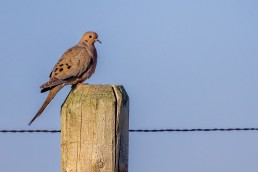Dove Season Offers a Social Side of Hunting
SHARE THIS POST
Brandon Butler extolls the virtues of dove hunting with family and friends, and says they make a great meal.
Dove hunting season has opened across much of the Midwest. Opening day is always popular. Public lands can be crowded early in the season. But as time goes on, the crowds thin out and many dove fields become void of competition. Doves are still around in droves, so don’t overlook these fast-flying, great-tasting birds as an excellent early season hunting opportunity.
A mature dove is only around 12 inches long, possessing a wingspan of 18 inches and weighing a whopping 6 ounces. Doves are small targets when you consider that they reach flight speeds up to 55 miles per hour. Knocking enough of them out of the air to fill a limit is a tough task.
Dove hunting is a challenging and exciting experience. The action can be fast and furious. Connecting with these pint-sized rockets isn’t. Spend some time practicing by shooting clay targets before hitting a dove field!
Practice your wing shooting at a trap and skeet club or sporting clays range before hitting the dove field. If you don’t have access to a commercial club or range, use your own clay thrower. These range from simple handheld throwers to professional machines. Something in the middle, like the Caldwell Claymore thrower, allows you to transport a good quality clay bird thrower to any field where you have permission to practice shooting. A few good practice sessions should save you some money on shells down the road, and some frustration from too many misses.
Minimal equipment is needed for dove hunting. Any 12-, 16- or 20-gauge shotgun will work fine. Some hunters prefer the challenge of a 28-gauge or .410. Take plenty of shotgun shells with you; you’ll need more than you think! Size 7 1/2 or 8 birdshot will suffice. Make sure you know if the property you are hunting on requires the use of steel shot or not. Many public properties require the use of steel shot only.
Are you enjoying this post?
You can be among the first to get the latest info on where to go, what to use and how to use it!
Try to locate an already harvested crop field with a water source nearby. Doves roost overnight and often fly to water in early morning and again at dusk. Keep the sun at your back. Doves are hard enough to hit without blinding yourself by looking into the sun. Camouflage isn’t necessary, but doves do have great eyesight. Hunter orange is not required but is a good idea when hunting in a group. Sitting still and breaking up your outline with natural brush, or sitting next to a structure of some sort, will bring more doves into range. Stay still until they are right on you. Don’t stand until you’re ready to shoot, or just shoot sitting down.
Doves are usually found in good numbers around harvested agricultural fields—especially grain fields. Scout early and late in the day, when doves are moving to and from fields, especially freshly picked fields. Look for doves on power lines and fences. They’ll hang around roosting areas and water holes, too.
Few hunting opportunities are better for spending time in the field as a family than dove hunting. You do need to be somewhat still and quiet when dove hunting, but you can talk and enjoy the company of those you are hunting with. There should be plenty of shooting action—or at least you hope so. If all goes well, you’ll end up with a pile of doves and sore shoulders.
Doves are great to eat. Each one provides two good-sized nuggets that when grilled, baked or fried, and offer a rich, delicious game meat. My favorite means of preparing dove breasts is to douse them in Worcestershire sauce, sprinkle with sea salt and cracked black pepper, wrap each breast in bacon, stick a toothpick through it, and drop it on the grill over medium heat.
If you want to try hunting a different, exciting species or technique, you’ll find plenty of suggestions in every issue of MidWest Outdoors. Subscribe on our website.
MWO
SHARE THIS POST
You may also like...
Nothing found.
Did you enjoy this post?
You can be among the first to get the latest info on where to go, what to use and how to use it!
Brandon Butler
As past executive director of the Conservation Federation of Missouri, Brandon Butler has made a name for himself by fighting to protect fish and wildlife, and critical habitats. His syndicated column, “Driftwood Outdoors,” appears in more than 30 newspapers, weekly, across Missouri and Indiana. Reach him via email at bbutler@driftwoodoutdoors.com.
